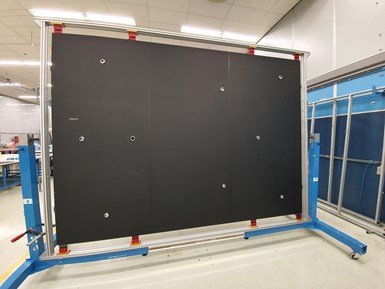Airborne substrate panels enable JUICE spacecraft solar array
Airborne delivers solar array substrate panels for use in the European Space Agency’s mission to explore the icy moons of Jupiter.

Source | Airborne
Airborne (The Hague, Netherlands) has delivered the last 4 out of 10 XL substrate panels to Airbus Defence and Space Netherlands (Leiden, Netherlands) for use in the solar array of European Space Agency’s (ESA) JUICE mission to Jupiter.
The JUICE (JUpiter ICy moons Explorer) is an interplanetary spacecraft in development by the ESA with Airbus Defence and Space Netherlands as the main contractor. The mission will study Jupiter’s moons Ganymede, Callisto and Europa.
Given extreme distance from the Sun, the JUICE spacecraft requires an exceptionally large solar array in order to generate sufficient power. Airborne was selected by Airbus Defence and Space Netherlands to develop and manufacture the XL substrate panels for JUICE’s solar array. With a total surface area of 85 square meters, the satellite will be equipped with the largest solar array ever flown on an interplanetary mission. Each individual panel has a surface area of 9 square meters. To enable production Airborne modified the manufacturing equipment, including extending the maximum inside diameter of the autoclave from 2.6 to 2.9 meters.

Source | Airborne
JUICE’s solar array is built with the new ARA Mk4 technology, which has been developed and qualified by Airbus Defence and Space Netherlands in close cooperation with Airborne. The technology allows for 20% cost reduction and increases the robustness of the solar array by expanding the temperature range and adding stiffness. As the satellite will be exposed to extreme conditions during the full length of the mission, the panels need to withstand temperatures as low as -240°C, as well as space radiation.
The substrate panel features the next generation of space prepregs developed by Toray Advanced Composites (previously TenCate Advanced Composites, Morgan Hill, Calif., U.S.), which, according to Toray, are used on areas including the facesheets, edge-members and patches. Toray RS-36, an epoxy-based thermoset prepreg for structural composite applications was selected as the material solution for ARA Mk4.
The extreme temperatures to which the satellite will be exposed near Jupiter made additional qualification necessary on the panel design and its interfaces. Airborne manufactured 160 qualification test samples and two full-size panels which were delivered in January 2017. After an intensive testing campaign by Airbus Defence and Space Netherlands, Airborne manufactured a total of 10 substrate panels. The last 4 panels were completed in October 2019. Launch of the JUICE mission is planned for 2022.
Arno van Mourik, CEO of Airborne says, “JUICE is a great example of what we can do in terms of state-of-the-art substrate panel technology for solar arrays of extremely demanding space missions. Building on this position we are determined to move forward in the domain of affordable space panels for new space. Combining our knowledge on high end substrates with our capabilities in the domain of industrialization of composites will allow us to provide the new space market with high performance, yet radically affordable solutions in high volumes.”
Related Content
-
Composites-reinforced concrete for sustainable data center construction
Metromont’s C-GRID-reinforced insulated precast concrete’s high strength, durability, light weight and ease of installation improve data center performance, construction time and sustainability.
-
From the CW Archives: Fast-cure epoxies for automotive fabrication
Sara Black’s 2015 report on the development of snap-cure epoxies for automotive manufacturing still resonates today.
-
Composite molding compound replaces Invar for lightweight small satellite structures
Patz Materials and Technologies and Lawrence Livermore National Laboratory developed a new monolithic optics housing with 80% less weight, near-zero CTE and the high-volume manufacturing required for commercial space.
















